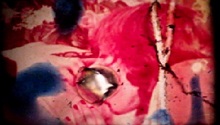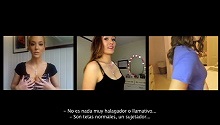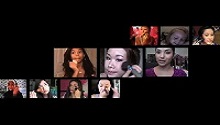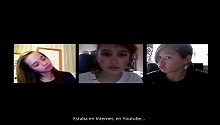Florencia Aliberti
Florencia Aliberti (Buenos Aires, 1986). I’ve been working in the audiovisual sector for a few years.
My work centres mainly on experimental video and film. My liking for junk, discarded images and, in general, things that have lost their use value, led me to start collecting old celluloid, videos (real and virtual), photos, projectors, cameras, magazines… So I started to work with recycled images.
My proposals are based on editing and the reuse of a variety of materials, and explore the possibilities of giving a new meaning to images, setting them in new contexts for reading and interpretation. Much of my work starts with an act of appropriation and develops through editing, with the clear intention of highlighting the mix of materials and questioning the given meaning of images.
I like experimenting with different formats, both analogue and digital (super 8, 8mm, collage, video, etc.) and manipulating supports to unleash chance in the creative process.
I studied Philosophy (University of Barcelona) and Filmmaking (CIEVYC, Buenos Aires).
http://www.floraliberti.tk/
Florencia Aliberti (Buenos Aires, 1986)
Some of Aliberti’s video collages (Horror vacui and Variaciones sobre Alicia) betray her interest in the art of the historic avant-garde movements, the forerunner to film editing techniques. She plays with the materiality of the image, with textures, an interest she shares with several generations of authors. It seems that the coldness of digital techniques has unleashed a general nostalgia for the more tactile appearance of celluloid and its formal qualities. But spectators will see two very different types of works here. The video entitled Prostética (Prosthetic) is a kind of hinge between two types of editing, using old material to address what is a recurrent theme in the second type: gender issues and the image of women in the new technological era.
Despite my appreciation for the former, here I will centre on the latter. “(Auto)exposiciones” ([Self]exhibitions) is a multiscreen series, a kind of choral construction comprising split screens where spectators have some scope to choose their own direction, to read the images in the order they prefer. Today’s spectators have a new sensibility; though less able to sustain attention for long periods, they are more able to grasp several things at the same time from a generalized dispersion, on the fly, so to speak. Harun Farocki wrote: “In a double projection, there is succession as well as simultaneity, the relation of an image to the one succeeding it as well as to the one next to it. A link with the previous and with the simultaneous.” Aliberti’s virtuoso edits put the public’s new attentive skills to the test: they are not trivial; they are judiciously measured and ordered. They manifest an interplay of virtual mirrors in which characters create their identity, are moulded (literally) by a common plan, becoming infected by what they see in the videos of others. A public exhibition of privacy that is different to the erotic tapes your parents made in Super 8 and then hid to bring out occasionally. A new expression of the fragile boundary between public and private.
On the Internet you have to study this kind of documents in the raw to try and give them an order or find a meaning. What is now known as “extimacy” (exhibited intimacy) immediately creates another layer, generating a new, deeper and more concealed privacy, just as the confession box implies another secret: what is concealed from the confessor. Aliberti seeks out the raw material that emerges from this new pseudo-intimacy of thousands of users, prosumers (producers-consumers) of varying degrees of ingenuousness; she compiles materials for the future history of a private life tainted by publicity. It is a fabulous research project which, apart from the vertigo it produces, illustrates and facilitates future sociological studies about clichés, gender image, fashion, contagion, the relation between public and private, etc. To my knowledge, in Barcelona at least, some university professors of history and theory of image are already using Aliberti’s videos in their classes.
In a world in which many people, against their will, live a long way from home and in whose lives the closest thing to the warmth of home is a smiley telling them that a family member is also on line, Florencia gives a human image to our cold condition as mere data in a statistical table about the sale of cosmetics or weight-loss programmes.
In the videos of little girls and adolescents (and then some) that she orchestrates here, the screens are windows, but they are also mirrors in which female users have seen others before making their own videos. They ask that mirror if they are pretty or ugly, and for help to lose weight, while giving beauty tips to others, thereby creating a kind of community. As Manuel Delgado writes in his blog: “the criterion of intersubjective recognition of these human groups is based not on agreement between consciousness but between experiences, in which the codification of appearances seems to occupy a central role. Culture in this case is used not so much to talk about a coherent way of living as a coherent way of appearing. [...] They aspire to be clearly identified, localized and detected.”
The vices that technology brings with it spread like the plague. Modern communication machines help to mould us, to discipline our bodies. The event, then, is the rampant multiplication of the same trivial gesture, and Aliberti’s videos manifest, like foam, the existence of a bigger, more ingrained problem. There are many similarities between the physical and virtual masses of individuals, and I think we cannot rule out Le Bon or Freud’s studies when exploring certain aspects of modern virtual masses. The condition of mass even equates us, in certain aspects and movements, with the masses of some animals.
Operative images are those which are not intended to inform or to entertain. For example, the images recorded by security cameras in a bank or the weight-loss diet videos used by Aliberti. But we all know that many images not filmed with this intention are brought back into circulation as information or entertainment: the Internet is full of images of the fence in Melilla and accident crash videos.
Although Aliberti presents these installations in galleries and seeks out the type of distance and decontextualization that take place there, it is only fair that her videos should go back to the Internet where they are available to anyone. They are a more accurate form of sociological analysis than many academic studies based on statistics and doubtful theories. Finally, as she writes, these videos show “private, individual experiences that are also permeated by something contagious, imitating and replicating forms of (self)representation that generate countless copies of the same by means of these same individual experiences”. I urge Aliberti to continue with this kind of work (without neglecting the other); it has created a genre which, in intelligent hands such as hers, is bound to produce more enlightening results.
Félix Pérez-Hita (Video artist and cultural critic)








